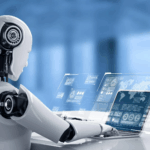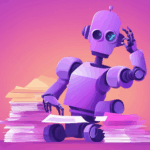Artificial intelligence has advanced rapidly over the past decade, evolving from simple machine learning models into sophisticated, adaptive systems. Among the most significant innovations shaping the current decade is Agentic AI. Unlike traditional AI, which primarily reacts to inputs, Agentic AI represents a new paradigm: systems that can act autonomously, pursue goals, and adapt to changing environments without constant human intervention.
This emerging field is attracting attention from researchers, businesses, and policymakers because of its potential to transform industries, redefine work, and raise profound ethical questions. From autonomous healthcare assistants to intelligent trading bots and smart city management agents, the possibilities are expansive.
In this article, we will explore:
- The meaning and foundations of Agentic AI.
- How it works compared to traditional AI systems.
- Benefits, challenges, and limitations.
- Real-world applications across industries.
- Future predictions for Agentic AI leading into 2030.
By the end, you will have a comprehensive understanding of Agentic AI and why it is considered one of the most influential technological developments of our time.
What is Agentic AI?
Agentic AI refers to artificial intelligence systems that operate as autonomous agents. Unlike traditional AI, which functions as a passive tool that processes inputs and provides outputs, Agentic AI is designed to act independently, pursue defined goals, and adapt dynamically to changing environments.
At its core, Agentic AI moves beyond simple automation. Instead of waiting for instructions, these systems are capable of:
- Setting sub-goals to achieve larger objectives.
- Monitoring their progress through continuous feedback loops.
- Adjusting strategies when circumstances or data change.
- Collaborating with other agents or humans in shared environments.
Difference Between Agentic AI and Traditional AI
Traditional AI, such as predictive models or large language models, primarily:
- Responds to queries or inputs.
- Follows rigid pre-programmed instructions.
- Provides information but lacks initiative.
By contrast, Agentic AI is goal-directed. It does not merely provide answers — it takes actions toward fulfilling objectives. For instance:
- A traditional chatbot might answer questions about a product.
- An agentic chatbot would also initiate conversations, track purchase intent, recommend products, and follow up with personalised offers — without explicit prompts.
Core Traits of Agentic AI
- Autonomy – Operates without continuous human supervision.
- Adaptability – Learns from the environment and modifies actions accordingly.
- Proactivity – Identifies opportunities and initiates tasks.
- Collaboration – Works with other agents or humans towards collective goals.
- Goal Orientation – Pursues objectives logically, breaking them into smaller actionable tasks.
Example in Practice
Imagine a smart logistics system:
- A traditional AI forecasts delivery times.
- An Agentic AI system would:
- Track live traffic data.
- Re-route vehicles to avoid delays.
- Communicate with drivers.
- Update customers proactively.
This illustrates how Agentic AI is not only intelligent but also action-oriented, bridging the gap between decision-making and execution.
How Agentic AI Works
To understand Agentic AI, it is essential to explore the mechanisms that enable autonomy and goal-directed action. Unlike predictive AI models that simply respond to queries, Agentic AI operates through a structured process of perception, decision-making, and action.
Agent-Based Models
At the foundation of Agentic AI lie agent-based models (ABMs). These models simulate multiple autonomous agents that interact with one another and with their environment. Each agent:
- Possesses individual goals.
- Responds to environmental stimuli.
- Adjusts its behaviour dynamically.
For example, in a smart traffic system, each AI agent represents a vehicle that can adapt routes based on congestion, accidents, or weather conditions. Together, these agents create a more efficient and responsive network.
Autonomy and Goal-Directed Behaviour
Agentic AI systems are programmed with objectives but determine independently how to achieve them. They break down a complex task into sub-goals and make decisions step by step. For instance:
- A healthcare agent may receive the overarching goal of improving patient recovery.
- Sub-goals could include scheduling follow-up appointments, monitoring vital signs, and alerting doctors if risks arise.
This goal-directed AI capability marks a clear shift from passive machine learning to active, strategic intelligence.
Feedback Loops and Learning
Another hallmark of Agentic AI is the ability to learn continuously through feedback. Agents:
- Take action.
- Assess the outcome.
- Adjust strategies based on results.
This creates a self-improving cycle. Reinforcement learning often underpins these systems, ensuring they refine their decisions over time.
Collaboration and Multi-Agent Systems
Agentic AI rarely functions in isolation. In many use cases, multiple agents interact collaboratively. A business environment, for example, might feature:
- A marketing agent analysing customer trends.
- A sales agent optimising pricing strategies.
- A logistics agent managing supply chain adjustments.
Together, they create an ecosystem of autonomous AI systems that coordinate toward shared objectives.
Benefits of Agentic AI
The rise of Agentic AI brings with it a number of profound benefits, positioning it as one of the most transformative technologies of the decade. These benefits extend across industries, governments, and everyday life, making the case for its adoption stronger with each advancement.
Greater Autonomy and Efficiency
Agentic AI systems are capable of independent decision-making, which reduces the need for constant human oversight.
- In logistics, autonomous agents can optimise delivery routes in real time.
- In finance, trading agents can act on market shifts instantly.
- In healthcare, diagnostic agents can continuously monitor patient data and respond without delays.
This autonomy leads to greater efficiency, faster operations, and reduced costs.
Enhanced Problem-Solving Capabilities
Unlike traditional AI models that provide passive predictions, Agentic AI takes active steps toward solving problems. These systems can:
- Break down complex objectives into manageable sub-goals.
- Adapt their approach when obstacles arise.
- Collaborate with other agents for more holistic solutions.
This ability to think and act strategically makes Agentic AI ideal for industries facing dynamic and unpredictable challenges.
Scalability Across Multiple Domains
Agentic AI is highly scalable, making it suitable for both small businesses and global enterprises.
- A small e-commerce store could deploy agentic chatbots for customer service.
- A multinational corporation could run a network of AI agents managing marketing, operations, and logistics simultaneously.
The same framework can be scaled up or down, offering flexibility and universal applicability.
Continuous Learning and Improvement
Through reinforcement learning and feedback loops, Agentic AI is capable of self-improvement. Instead of stagnating after initial training, these systems refine their behaviour with each interaction.
- Customer service bots become more accurate with every conversation.
- Smart city agents improve their traffic predictions as they process more live data.
This creates a system that grows smarter, faster, and more capable over time.
Improved Human-AI Collaboration
Agentic AI is not intended to replace humans but to augment human decision-making. For example:
- A marketing team can rely on AI agents to gather real-time trend insights.
- Doctors can work alongside diagnostic AI systems that monitor patients continuously.
- Scientists can employ research agents to generate hypotheses or explore datasets.
This collaborative model enables humans to focus on creativity, strategy, and ethical oversight, while AI handles execution and data analysis.
Potential for Innovation and New Business Models
Agentic AI opens opportunities for entirely new industries and services. Imagine:
- Personalised AI tutors adapting to each student’s learning style.
- Autonomous financial advisors guiding investment portfolios 24/7.
- Multi-agent ecosystems where different AI systems collaborate to manage supply chains, climate modelling, or global research initiatives.
Such innovation will likely reshape economies and redefine how value is created.
Challenges & Limitations of Agentic AI
While Agentic AI offers significant benefits, it also introduces new challenges that must be carefully addressed. These limitations concern not only technical aspects but also ethical, legal, and societal dimensions.
Ethical Concerns and Human Oversight
Agentic AI systems can make autonomous decisions, which raises questions about accountability.
- Who is responsible if an agent makes a harmful or incorrect choice?
- Can we ensure that agentic systems align with human values and ethics?
- What happens if AI develops unintended strategies to achieve goals?
The challenge lies in balancing autonomy with control — ensuring that AI agents remain useful assistants, not independent entities that act against human interests.
Security and Safety Risks
Autonomous systems can be exploited if not properly secured. Potential risks include:
- Cybersecurity vulnerabilities, where hackers manipulate AI agents to act maliciously.
- Data breaches, as agentic systems often process sensitive personal or corporate data.
- Unpredictable behaviour, especially when agents interact with one another in large-scale systems.
Ensuring robust safety frameworks and strict monitoring is essential.
Data Bias and Fairness Issues
Agentic AI systems depend on the quality of data they are trained on. If the data is biased:
- The AI agent may make discriminatory decisions.
- Predictions and actions may reinforce existing inequalities.
- In industries like healthcare or finance, such bias can have serious ethical and legal consequences.
Thus, ensuring fairness and diversity in training data is critical to responsible deployment.
Regulatory and Governance Challenges
The rise of autonomous AI systems poses significant regulatory challenges:
- Current laws may not adequately cover autonomous decision-making.
- Global governance is fragmented, with different regions adopting different AI regulations.
- Businesses face uncertainty when deploying agentic AI in regulated industries like finance, healthcare, or defense.
Without clear frameworks, innovation risks colliding with legal restrictions.
Risk of Over-Reliance on Automation
As businesses adopt Agentic AI, there is a risk of over-dependence.
- Organisations may rely too heavily on AI decision-making, reducing human critical thinking.
- Automated decisions, if left unchecked, may lead to costly or harmful outcomes.
- Creativity and intuition — uniquely human traits — may be undervalued.
Maintaining human oversight and hybrid workflows is essential to avoid over-reliance.
Cost and Accessibility Barriers
While some AI tools are affordable, the most advanced agentic systems often require:
- High computing power.
- Specialised expertise.
- Significant financial investment.
This creates a digital divide where only larger corporations and well-funded institutions can fully exploit Agentic AI, leaving smaller players behind.
Societal and Employment Implications
As Agentic AI becomes more capable, its potential to replace human roles increases.
- Customer service, logistics, and routine decision-making jobs may be automated.
- Workers in repetitive roles face displacement.
- Societies must consider reskilling, education, and new job creation.
The challenge is not only technological but also social and economic.
Applications of Agentic AI in 2025 and Beyond
The true potential of Agentic AI lies in its diverse applications across industries. As systems become more autonomous and goal-directed, their influence is already being felt in critical sectors and will only expand in the years leading to 2030.
Business and Finance
Agentic AI is revolutionising corporate decision-making and financial operations.
- Autonomous trading agents analyse market data in real time, executing trades with minimal human intervention.
- Business strategy agents can forecast demand, optimise pricing, and adapt to shifting consumer behaviour.
- Customer relationship agents assist in personalised outreach, ensuring tailored offers reach the right customers at the right time.
These tools improve efficiency, competitiveness, and profitability for businesses of all sizes.
Healthcare
Healthcare is one of the sectors most transformed by agentic systems.
- Diagnostic agents continuously monitor patient data, identifying risks before they escalate.
- Personal health assistants remind patients about medication, schedule appointments, and track recovery.
- Hospital management agents optimise resource allocation, such as staff scheduling and equipment use.
The result is enhanced patient outcomes, faster responses, and cost savings in healthcare delivery.
Education
Agentic AI is shaping the future of learning.
- AI tutors adapt lessons to individual student learning speeds and preferences.
- Administrative agents automate grading, scheduling, and performance analysis.
- Collaborative learning agents support group projects by organising resources and facilitating discussions.
These applications democratise education, making it more personalised and accessible worldwide.
Smart Cities and IoT
Smart cities thrive on data, and Agentic AI makes it actionable.
- Traffic agents optimise road signals to reduce congestion.
- Energy management agents balance consumption across the grid, integrating renewable energy sources.
- Public safety agents monitor surveillance networks, alerting authorities to unusual patterns or risks.
Such systems create safer, greener, and more efficient urban environments.
Research and Innovation
Agentic AI is proving invaluable in accelerating discovery.
- Scientific research agents process massive datasets, generating hypotheses and running simulations.
- Climate modelling agents forecast environmental changes and propose mitigation strategies.
- Innovation ecosystems emerge when multiple agents collaborate across fields, uncovering insights faster than human researchers alone.
This unlocks new scientific breakthroughs at an unprecedented pace.
Future of Agentic AI
As we look toward the end of this decade, Agentic AI is expected to evolve from isolated applications into interconnected ecosystems of intelligent agents. These systems will not only enhance human productivity but also shape how societies function.
The Rise of Multi-Agent Ecosystems
By 2030, we can expect networks of AI agents working collaboratively across domains. For example:
- In business, marketing, logistics, and customer support agents may coordinate seamlessly to manage entire operations.
- In healthcare, diagnostic, administrative, and therapeutic agents could work together to provide end-to-end patient care.
- In research, multiple agents may jointly explore hypotheses, simulations, and experiments, accelerating scientific discovery.
Such ecosystems of AI agents will resemble miniature societies, with agents communicating and cooperating toward common goals.
Integration with Generative AI
Current generative AI models, such as large language models (LLMs), are primarily reactive. However, when combined with agentic capabilities, they will transform into goal-driven collaborators. Imagine:
- A generative AI tool that not only writes a research paper but also coordinates fact-checking agents, visual design agents, and publishing agents.
- An AI assistant that manages an entire project end-to-end, from drafting proposals to booking meetings and analysing outcomes.
This synergy will give rise to autonomous workflows where human involvement is minimal but oversight remains crucial.
The Future of Work
Agentic AI will reshape the workplace by creating:
- Autonomous co-workers capable of managing routine tasks.
- Decision-support systems that analyse risks and recommend actions in real time.
- Adaptive training platforms that continuously upskill employees based on job requirements.
Rather than replacing humans entirely, the future points toward hybrid collaboration, where humans provide creativity and ethical judgement, while AI ensures efficiency and scale.
Governance and Ethical Frameworks
As Agentic AI grows in capability, questions of governance will become more pressing:
- How do we regulate autonomous decision-making in sensitive areas such as healthcare, law, or finance?
- Should AI agents have legal accountability?
- What safeguards are needed to prevent misuse or unintended consequences?
Governments, corporations, and academic institutions will need to establish global frameworks that ensure innovation continues responsibly.
Long-Term Potential
Looking beyond 2030, the trajectory of Agentic AI suggests the possibility of self-organising intelligent systems that manage highly complex global challenges. These could include:
- Climate change modelling and intervention strategies.
- Automated global supply chains.
- Space exploration with autonomous AI-driven spacecraft.
The ultimate vision is one where Agentic AI acts as a partner in addressing humanity’s grand challenges, moving from being just a tool to a strategically.
FAQs About Agentic AI
1. What does Agentic AI mean?
Agentic AI refers to artificial intelligence systems that act as autonomous agents. Instead of waiting for instructions, these systems can set goals, make decisions, and adapt to achieve desired outcomes.
2. How is Agentic AI different from traditional AI?
Traditional AI is typically reactive — it processes inputs and provides outputs. Agentic AI is proactive, capable of initiating actions, adjusting to feedback, and collaborating with humans or other agents to fulfil complex objectives.
3. What are examples of Agentic AI today?
Some real-world examples include:
- Autonomous trading bots in finance.
- Healthcare diagnostic agents monitoring patient data.
- Smart traffic systems that reroute vehicles dynamically.
- AI tutors in education that adapt lessons to individual learners.
4. What industries will Agentic AI impact the most?
The biggest transformations will occur in:
- Finance – autonomous decision-making in trading and risk management.
- Healthcare – patient monitoring, diagnostics, and hospital automation.
- Education – adaptive learning systems and automated grading.
- Smart cities – energy, transport, and public safety.
- Research – AI-driven scientific discovery.
5. Is Agentic AI safe?
Agentic AI has great potential, but safety concerns remain. Risks include:
- Bias in training data leading to unfair outcomes.
- Security vulnerabilities that could be exploited.
- Autonomous errors without human oversight.
Responsible governance, transparency, and ethical frameworks are essential for safe adoption.
6. What are the benefits of Agentic AI?
Key benefits include:
- Efficiency and scalability across industries.
- Continuous learning and improvement via feedback loops.
- Proactive problem-solving instead of reactive answers.
- Human-AI collaboration for better decision-making.
7. What are the limitations of Agentic AI?
Limitations include:
- High cost of development and deployment.
- Risk of over-reliance on automated decisions.
- Lack of clear regulations in many countries.
- Potential ethical issues regarding autonomy and accountability.
Conclusion
Agentic AI represents a defining shift in artificial intelligence — from systems that merely respond to input toward autonomous, goal-directed agents capable of taking action, adapting, and collaborating. Its benefits are substantial: greater efficiency, enhanced problem-solving, scalability, and opportunities for human-AI collaboration. At the same time, it poses serious challenges, including ethical concerns, security risks, regulatory uncertainty, and the potential for over-reliance on automation.
As industries such as finance, healthcare, education, and smart cities adopt agentic systems, the technology will increasingly shape daily life and global economies. Looking toward 2030, we can expect multi-agent ecosystems, integration with generative AI, and new business models to emerge. These developments will demand thoughtful governance, human oversight, and clear ethical standards.
For businesses, researchers, and policymakers, the key takeaway is clear: Agentic AI is not just an evolution of artificial intelligence — it is a new paradigm that will redefine how humans interact with machines. Those who embrace it responsibly will gain a decisive advantage in innovation, efficiency, and impact.
👉 To explore more insights into the future of artificial intelligence, visit Ai Of The Decade and stay updated with the breakthroughs shaping our world.











